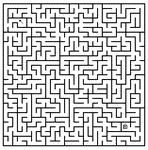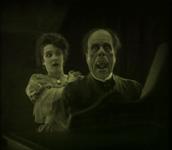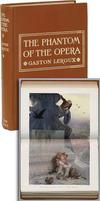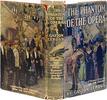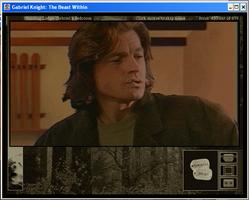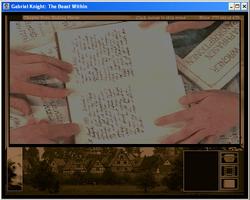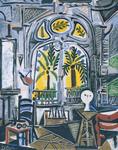This entry develops on an idea from this entry.
You’ve heard this one before:
Reader, suppose you were an idiot. And suppose you were a member of Congress. But I repeat myself.
-Mark Twain
Why didn’t Twain just say “All members of Congress are idiots”? Because, of course, that wouldn’t have been clever. And yet what he says is essentially equivalent in meaning. Only the most trivial logic is necessary to determine that he has, in fact, said that all members of Congress are idiots. If B = A implies B = C, then A = C. (B is “you,” A is “a member of Congress” and C is “an idiot”) This is a close relative of the old “transitive property” from middle school math: If A = B and B = C, then A = C. It’s not just math, it’s in our guts. Your subconscious can work this stuff out and chew gum at the same time.
The statement “Congress is made up of idiots” is not clever and the Twain quote is clever simply because the meaning of the Twain quote has been thinly disguised with a simple transitive property shuffling.* Twain of course wants us to get what he’s saying immediately, so it’s not really disguised. On the other hand, he doesn’t want us to get what he’s saying immediately immediately – he wants it to be clever.
This is what it means to say that one has to “get” a joke, whereas one hopefully doesn’t have to “get” a sentence. The “getting” is what makes the joke entertaining, as can easily be demonstrated by ruining jokes:
A guy walks into a bar with a 12-inch pianist and has it perform for the bartender. The bartender asks him where he got it. “Well,” he says, “I found a genie in a lamp and made a wish.” “You wished for a 12-inch pianist?” “No,” says the guy, “I wished for a 12-inch penis, but I guess the genie misheard me!”
The joke has been obliterated by turning the trivially indirect into the actually direct. Oblique = clever.
Jokes and witticisms are just an example of a general principle that I was going to call the “intransitive property” but that’s too stupid. Whatever its name should be, the principle is this: indirectness, even the most trivial indirectness, creates a powerful illusion of substance. The transitive property seems to suggest that the indirect can have an exact equivalent in the direct, but as far as the human response goes, the indirect is irreducible. When John Lennon sings “one and one and one is three,” he manages to surprise and amuse us with the profoundly obvious.
What does this have to do with computer games? Lots and lots. But one more concept first.
In current usage, a “labyrinth” is a single twisty path like this, with no branching. It might seem convoluted, but you can just follow it from beginning to end without any opportunity to go wrong.
A “maze,” on the other hand, is a complicated map like this, with lots of branching. It offers the problem but hides the solution, and you have to work it out. It is, in short, a puzzle, and requires puzzle-solving thought.
Being at the beginning of a labyrinth is informationally equivalent to being at the end – unlike being at the beginning of a maze, you have nothing left to learn. All you have left to do is follow the path. And yet this “informational equivalence” does not detract from the fact that people find the experience of being in a labyrinth comparable to the experience of being in a maze. It feels somehow “puzzly.” It feels like you’re doing something, to walk a labyrinth. It’s fun, in a way that walking a long straight line isn’t.
You see what I’m saying. Just like with jokes, it is the convolutions that create the sensation of substance. A topographic analysis would suggest that a labyrinth goes nowhere, but the experience is different. The illusion of content is strong.
So, finally, to my point:
Computer adventure games are all about the problem of turning a story into a game. There are some fundamental, definitional incompatibilities between the two: stories progress of their own volition in a pre-determined direction (otherwise, they’re not stories); games progress due to a player in an undetermined direction (otherwise, they’re not games). The situation is more complicated than that (and I’ll write about it in more depth some other time), but for most designers, the basic problem is: how to block up a story so that it won’t “go” without a player, and/or how to limit or “fix” a game so that it goes somewhere in particular.
Common wisdom has it that adventure games usually solve this problem by filling the stories with “puzzles,” but I put it to you that adventure games aren’t full of puzzles; they’re really full of labyrinths: tasks that pose no actual challenge and nonetheless feel like meaningful participation. It’s actually a brilliant, elegant solution to the problem of making a fundamentally linear process (the telling of a story) reminiscent of an open-ended, non-linear one (the playing of a game): employing that strange principle of indirectness.
Real puzzles do appear in games, of course. Frequently (a little too frequently, if you ask me) a character will come across a door locked with a real puzzle; some kind of wire-routing puzzle or a combinatorial button-pushing puzzle, or something like that. Those are puzzles – you look at them and you know what you want to do but you don’t know how to do it until you’ve done some specialized thinking.
And I think it’s a clear indication of how little actual “puzzling” there is in games that these experiences stand out as blatantly self-contained. The bottom line is that posing a real, thought-worthy puzzle requires establishing a very rigorous set of abstract constraints. That’s why they don’t really mesh well with non-abstract stories and have to appear as puzzle locks, etc. (“This house was built by a crazy man who was obsessed with puzzles!” is a standard computer game cop-out.)
Labyrinths – fake puzzles, fake obstacles – are the real stuff of adventure games. Games are full of conversations where the interaction consists of clicking on every possible option. That’s not puzzle-solving, and it doesn’t take thought. Why do players put up with this? Because the player feels, however irrationally, that there’s a substantial difference between interactivity and non-interactivity – even trivial interactivity. Within limits, of course; if the same conversation menu were replaced with a single button called “next topic,” I think that would cross the line into tediousness for most players. There are lots of games that don’t quite pull it off, and their conversation menus do seem like mere tedium. The labyrinth is too reminiscent of a straight path. Adventure games, for the most part, have been exercises in the art of dressing up trivial interactivity to most effectively suggest meaningful interactivity.
Back when I played The Secret of Monkey Island (1990) – a real landmark in the history of that art, a triumph of deliberate, calculated obviousness – I only got “stuck” once, and that was because I overlooked a perfectly reasonable hotspot (clickable, active area) on my initial assessment of a room and then had to search absolutely everywhere until I found my oversight. But that was my slip-up, not theirs. The game carefully made it possible for me to be continuously progressing forward. At every obstacle, it indicated – gently, indirectly, but unambiguously – where to go next. And I wouldn’t have wanted it any other way.
I’m not at all saying that’s the best possible way for adventure games to work. I’m just saying that’s the way most games aspired to work, and we should acknowledge that we’re not talking about a puzzle-based experience; we’re talking about a peculiarly effective pseudo-puzzle experience. That’s an important distinction, because making a good game on that model means designing not a good maze but a good labyrinth.
What makes an ideal labyrinth? I’m not sure. It’s all tied up in there somewhere – the amount of trivial obliqueness that makes a joke funniest; the amount of superficial indirectness that makes a quip cleverest.
I worry that a lot of attempts to build story games in this tradition are doomed because the designers don’t recognize what kind of trick it is they’re trying to pull. In fact, I think it’s one of the causes of the death of that tradition that only a few designers really knew what the name of the game was. The others thought they were actually giving the player options and challenging him with puzzles. So, designers, listen: coaxing your player through a simple labyrinth is a legitimate game design strategy. Even if the players don’t think that’s what they want, they like it; it works. Start by admitting to yourself that that’s your dirty little secret, and then be intelligent about dressing it up and heightening the illusion. Monkey Island and its friends were all about dressing. They weren’t fundamentally about freedom or non-linearity or any of that; they lived off the potency of elegantly superficial gestures toward freedom and non-linearity.
Okay, that’s enough for now, but this topic stretches in many directions. More to come.
* Okay, obviously there are other reasons why Twain’s quote is clever. One is that he is employing and then betraying a stock rhetorical device (“suppose you were an X”), much in the manner of “Take my wife…please!” Another is that by placing “idiot” first, he actually whimsically suggests not that all members of Congress are idiots, but that all idiots are definitionally members of Congress – an absurdly unnecessary overstatement of a case that is already exaggerated. But the main crux of the cleverness is as argued above; namely, that it is oblique.

